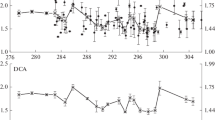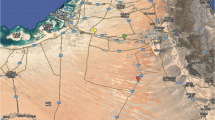Abstract
The observations on ground-based facilities miss multitudes of small fragments of space debris. However, the intrusion of fine particles into the atmosphere and their subsequent burning can be observed along with the usual meteor phenomena. Since the solar system meteoric body velocities at the entry into the atmosphere are over 11.2 km/s, and the velocity of the space debris objects does not exceed 11.2 km/s, the selection of meteors by velocity is a reliable criterion for separating these bodies. The paper describes a method of selecting the space debris fragments using a technique of television meteor monitoring. The technique was adapted on the material of real television observations on the FAVOR wide-field monitoring camera with high temporal resolution, conducted in 2006 in the Arkhyz station of the Institute for Precision Instrumentation (North Caucasus).
Similar content being viewed by others
References
L. V. Rykhlova, in Problema zaselennosti kosmosa (Space Population Problem), Ed. by A.G. Masevich (Kosmoinform, Moscow, 1993), p.7 [in Russian].
A. I. Nazarenko et al., GOST R 25645.164-97. Ensuring environmental safety of rocket and space technology. Model of spatial-temporal distribution of the flux density of man-made substance in the near-Earth space (State Committee of the Russian Federation for Standardization and Metrology, Moscow, 1997) [in Russian].
A. I. Nazarenko et al., GOST 134-1022-99. The near Earth space. Model of spatial-temporal distribution of the flux density of man-made substances (Russian Space Agency, Moscow, 1999) [in Russian].
GOST R 25645.167-2005. Space environment (natural and artificial). Model of spatial-temporal distribution of the flux density of man-made substances in outer space (State Committee of the Russian Federation for Standardization and Metrology, Moscow, 2005) [in Russian].
Orbital Debris Engineering Model ORDEM2000-v 1.0 (NASA, JSC, 2000).
Meteoroid and Space Debris Terrestrial Environment Reference Model, Release 1.0 (ESA SDCD03, 2000).
A. V. Bagrov, G. T. Bolgova, and V. A. Leonov in Proc. of Intern. Conf. Astroeko 2002 (Kiev, MAO ASU, 2003), p. 265.
A. V. Bagrov and V. A. Leonov, Astronomicheskii Vestnik 44, 352 (2010).
A. V. Bagrov, G. M. Beskin, A. V. Biruykov, et al. in Proc. of Intern. Conf. Near Earth Astronomy 2003, Vol. 2 (VVM Ltd., St. Petersburg, 2003), p.101.
I. S. Astapovich, Meteornie yavleniya v atmosfere Zemli (Meteor Phenomena in Earth’s Atmosphere) (Physmatgiz, Moscow, 1958), p. 196 [in Russian].
A. I. Nazarenko, Astronimicheskii Vestnik 36, 555 (2002).
L.V. Rykhlova et al., Adv. Space Res. 19, 313 (1997).
Author information
Authors and Affiliations
Additional information
Original Russian Text © V.A. Leonov, A.V. Bagrov, 2011, published in Astrofizicheskij Byulleten, 2011, Vol. 66, No. 1, pp. 93–96.
Rights and permissions
About this article
Cite this article
Leonov, V.A., Bagrov, A.V. Study of space debris burning in Earth’s atmosphere via television meteor monitoring. Astrophys. Bull. 66, 87–89 (2011). https://doi.org/10.1134/S1990341311010081
Received:
Accepted:
Published:
Issue Date:
DOI: https://doi.org/10.1134/S1990341311010081




